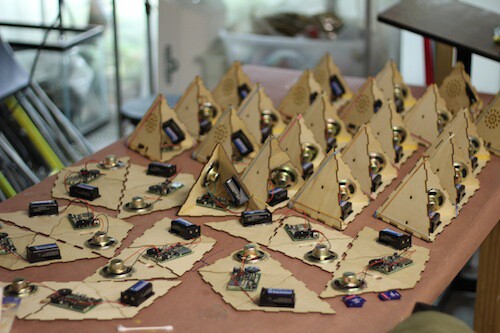Breaking Sound Barriers with Fol Chen

A while back, Samuel Bing and Sinosa Loa, members of the synthpop band Fol Chen, hosted their beta You Will be My Music workshop at artist-run storefront, Machine Project. They plan to do these workshops at as yet undisclosed art spaces while on tour promoting their recently released album, "False Alarms." Each session lasts one hour, and Bing and Loa spend that time helping one person impressionistically "cover" a song of their choosing, using various instruments and digital tools.
One instrument they had with them at Machine was a little red sampling keyboard that can record vocals you make and then play them back to you, more or less syncing them to the notes on the chromatic scale. During the first You Will be My Music session, a soft-spoken Woodbury college student covering George Michael's "Careless Whisper" recorded herself saying "meow" on the keyboard. But whenever Loa tried to play a phrase from Michael's song using the calibrated meows, it sounded off.
"Why does this second note sound funny to me?" she asked Bing.
"Well, it's not really a note," he said. "It's the sound of a cat."
Later, the Woodbury student decided the best way to approximate the saxophone riff that rises and falls throughout "Careless Whisper" would be through a chorus of voices singing "wee." Everyone present except the three illustrators working on George Michael-inspired album art near the front window and Bing, who had to man the computer--gathered around a microphone to sing "wee wee wee wee." In George Michael's recording, this riff sounds suave; this interpretation sounded more like organized screeching, though strangely melodic screeching. "One question," Bing asked, before finalizing the track. "Should I edit out the giggles?"
The first You Will Be My Music workshop had four participants and so lasted four hours. Machine Project's director Mark Allen - Allen and Bing were classmates at CalArts at the end of the nineties and have done projects together before -- solicited these participants by sending out emails to Machine members. In addition to the soft-spoken college student who remade "Careless Whisper," a precocious 12-year-old came to cover "Birdhouse in Your Soul" by They Might be Giants; a man who may have known too much about music to enjoy the haphazardness of Fol Chen's approach came to cover a Brian Eno track; and a woman with a soft spot for Rod Stewart came to cover "Young Turks." Each left with a personally illustrated CD.
None of the covers necessarily sounded like the song that inspired them. "You wouldn't have blinked if we told you this was an example of 20th century avant-garde composition," says Bing, "though not necessarily a good one."
Fol Chen, which includes producer Julian Wass in addition to Loa and Bing, began playing together in 2009 and their danceable, sometimes futuristic but never heavy-handed music -- "screwball pastiche pop," August Brown called it in the L.A. Times -- is made with computers and built up layer by layer in the studio. Since the start, they have done experiments that involve inviting non-band members and non-musicians into their music-making process, largely because their approach to music production is so hard to translate into live settings.
"We're about accidents that happen in the studio," explains Bing, and inviting participation is one way of bringing that "interest in chance into real time."
A song generated by the answers to the questionnaire submitted by a museum visitor named Abbie.
In 2010, during a performance in St. Petersburg, Loa and Bing invited audience members to help them construct a new Fol Chen song. At the Walker Art Center in 2011, they spent a day working out of a closet, using pre-developed algorithms to make tracks in response to surveys visitors filled out. Also in 2011, they debuted a tool called "The Tetrafol," a battery-powered wooden tetrahedron with circuits inside that could detect motion and would modify the playback of Fol Chen microcompositions as its position changed.

These experiments tend to be best received when they occur in experimental art spaces, places already interested in probing the relationship between viewer and object and seeing art as an experience that always involves audience engagement. In the summer of 2010, when Fol Chen had a residency at the Echo Park concert venue The Echo , they staged one performance in which the metal band Viscera covered their entire set and another in which they auditioned lead singers solicited through Craigslist live. "It could have been a total train wreck," wrote the L.A. Weekly the day after the Craigslist concert. It wasn't. By all measures, it was massively successful. The Craiglist singers had rehearsed in advance, the audience stayed, responded, bought drinks. "I'm still afraid I'll jinx it by talking about it," says Bing. Still, the Echo isn't inclined to ask Fol Chen back. "As soon as you change the venue," says Bing, "experimental" becomes suspicious.


When the False Alarm tour returns to Los Angeles tonite, Fol Chen may do a live version of You Will Be My Music, covering a song while onstage, soliciting audience input though Bing isn't yet sure how the logistics will work on that scale, or necessarily what the goal would be. "I feel like it's easy to talk the talk about bringing the public in," says Bing and harder to figure out how to do it in a way that's productive and resonant for all parties.
"It seemed mostly friendly, the idea," says Bing of You Will Be My Music. "With this, I like talking to them about the song. I was genuinely touched, in a non-spiritual way, by their feelings." He liked that Evan, the 12-year-old, said "You can't improve on perfection" when talking about They Might Be Giants ("We're going to," Bing replied). He liked having a reason to think about the cheesy, abrupt narrative Rod Stewart spins in Young Turks.
"I think you can address some issues about how you describe an aesthetic experience through something like this," Bing observes. "When these things work, everyone ends up having a good time and it's a way to think about how music gets made and how we receive it."
Dig this story? Sign up for our newsletter to get unique arts & culture stories and videos from across Southern California in your inbox. Also, follow Artbound on Facebook and Twitter.


